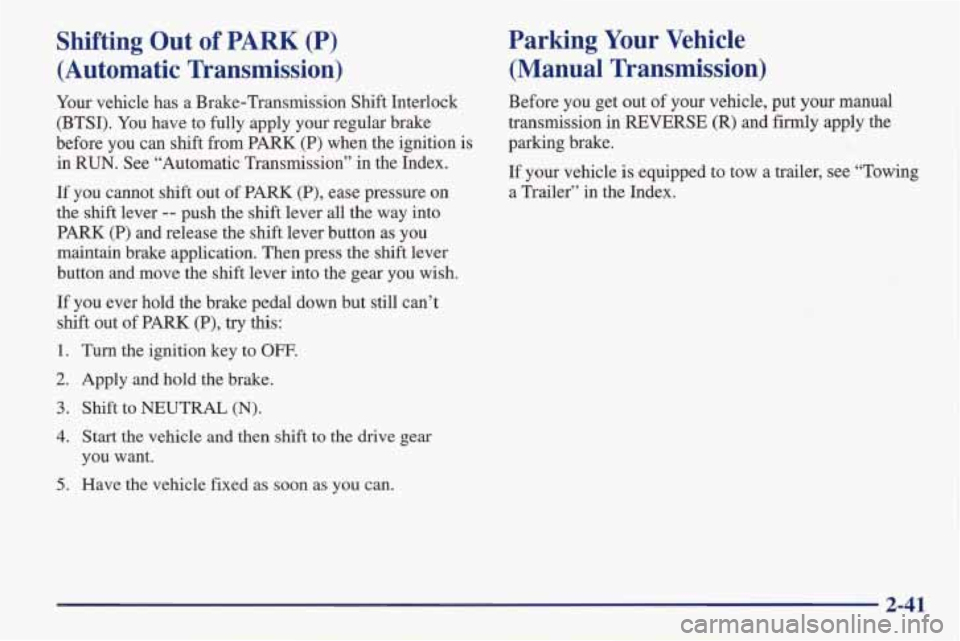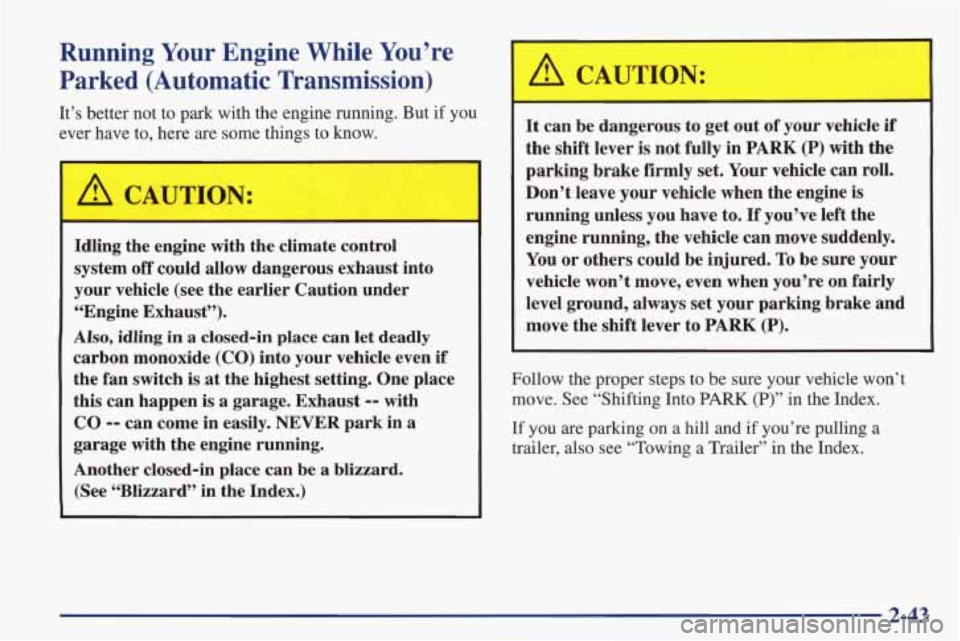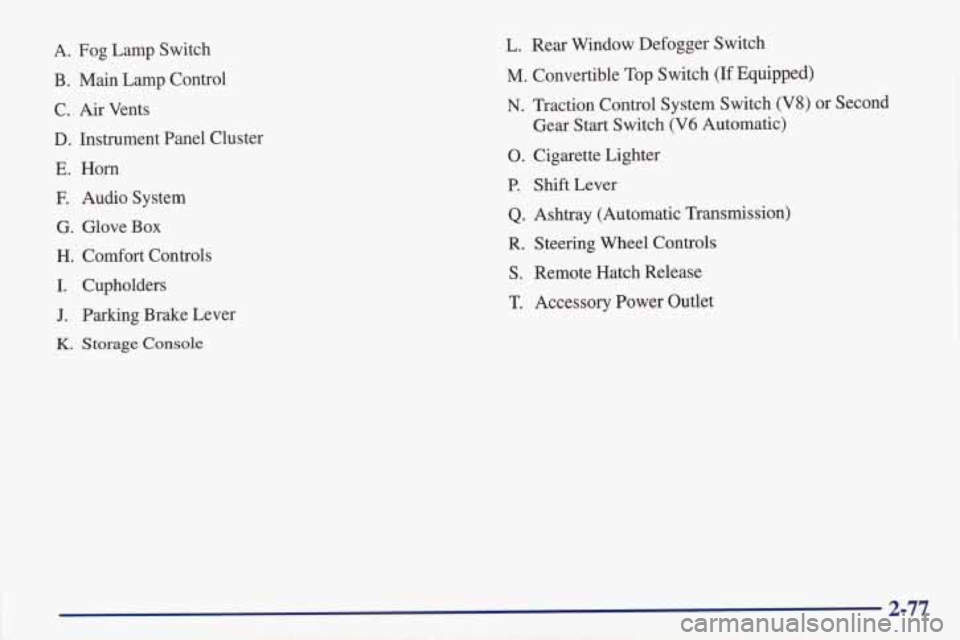automatic transmission PONTIAC FIREBIRD 1998 User Guide
[x] Cancel search | Manufacturer: PONTIAC, Model Year: 1998, Model line: FIREBIRD, Model: PONTIAC FIREBIRD 1998Pages: 406, PDF Size: 18.23 MB
Page 95 of 406

Leaving Your Vehicle With the Engine
Running (Automatic Transmission
Only)
It can be dangerous to leave your vehicle with the
engine running. Your vehicle could move
suddenly if the shift lever
is not fully in PARK (P)
with the parking brake firmly set. And, if you
leave the vehicle with the engine running, it could
overheat and even
catch fire. You or others could
be injured. Don’t leave your vehicle with the
engine running unless you have to.
Torque Lock (Automatic Transmission)
If you are parking on a hill and you don’t shift your
transmission into
PARK (P) properly, the weight of the
vehicle may put too much force on the parking pawl in
the transmission. You may find
it difficult to pull the
shift lever out
of PARK (P). This is called “torque lock.”
To prevent torque lock, set the parking brake and then
shift into
PARK (P) properly before you leave the
driver’s seat.
To find out how, see “Shifting Into
PARK (P)” in the Index.
When you are ready
to drive, move the shift lever out of
PARK (P) before you release the parking brake.
If torque lock does occur, you may need to have another
vehicle push
yours a little uphill to take some of the
pressure from the parking pawl
in the transmission, so
you can pull the shift lever out of PARK (P).
2-40
Page 96 of 406

Shifting Out of PARK (P)
(Automatic Transmission) Parking Your Vehicle
(Manual Transmission)
Your
vehicle has a Brake-Transmission Shift Interlock Before you get out of your vehicle, put your manual
(BTSI). You have to fully apply your regular brake transmission in REVERSE \
(R) and firmly apply the
before you can shift from PARK (P) when the ignition is parking brake.
in RUN. See “Automatic Transmission” in the Index.
If
you cannot shift out of PARK (P), ease pressure on a Trailer” in the Index.
the shift lever
-- push the shift lever all the way into
PARK
(P) and release the shift lever button as you
maintain brake application. Then press the shift lever
button and move the shift lever into the gear you wish. If
your vehicle
is equipped to tow a trailer, see “Towing
If you ever hold the brake pedal down but still can’t
shift out of PARK (P), try this:
1. Turn the ignition key to OFF.
2. Apply and hold the brake.
3. Shift to NEUTRAL (N).
4. Start the vehicle and then shift to the drive gear
you want.
5. Have the vehicle fixed as soon as you can.
2-41
Page 98 of 406

Running Your Engine While You’re
Parked (Automatic Transmission)
It’s better not to park with the engine running. But if you
ever have to, here are some things to know.
A CAUTION: I
Idling the engine with the climate control
system
off could allow dangerous exhaust into
your vehicle (see the earlier Caution under
“Engine Exhaust”).
Also, idling in a closed-in place can let deadly
carbon monoxide
(CO) into your vehicle even if
the fan switch is at the highest setting. One place
this can happen is
a garage. Exhaust -- with
CO
-- can come in easily. NEVER park in a
garage with the engine running.
Another closed-in place can be a blizzard.
(See “Blizzard” in the Index.)
A CAUTION:
It can be dangerous to get out of your vehicle if
the shift lever is not fully in PARK
(P) with the
parking brake firmly set. Your vehicle can roll.
Don’t leave your vehicle when the engine
is
running unless you have to. If you’ve left the
engine running, the vehicle can move suddenly.
You
or others could be injured. To be sure your
vehicle won’t move, even when you’re on fairly
level ground, always set your parking brake and
move the shift lever to PARK
(P).
Follow the proper steps to be sure your vehicle won’t
move. See “Shifting Into
PARK (P)” in the Index.
If you are parking on a hill and if you’re pulling a
trailer, also see “Towing a Trailer” in the Index.
2-43
Page 105 of 406

When you apply your brakes or push the clutch pedal
(manual transmission), the cruise control shuts off.
Setting Cruise Control
A CAUTION:
- -
Cruise control can be dangerous where you
can’t drive safely at
a steady speed. So,
don’t use your cruise control on winding
roads or
in heavy traffic.
slippery
roads. On such roads, fast changes
in tire traction can cause needless wheel
spinning, and you could lose control. Don’t
use cruise control on slippery roads.
Cruise control can be dangerous on
If your vehicle is in cruise control when the optional
traction control system begins to limit wheel spin, the
cruise control will automatically disengage. (See
“Traction Control System”
in the Index.) When road
conditions allow
you to safely use it again, you may turn
the cruise control back on.
If you leave your cruise control switch on when
you’re not using cruise, you might hit
a button
and
go into cruise when you don’t want to. You
could be startled and even lose control. Keep the
cruise control switch off until you want to use it.
1. Move the cruise control switch to ON.
2. Get up to the speed you want.
3. Push in the SET button at the end of the lever and
release it.
4. Take your foot off the accelerator pedal.
2-50
Page 115 of 406

When carrying large or heavy items, it is a good idea to
open
the panel and place the items in the rear area.
I A CAUTION:
An improperly stored close-out panel could be
thrown about the vehicle during a collision
or
sudden maneuver. You or others could be
injured.
If you remove the cover, always store it
outside your vehicle. When you put it back,
always be sure that it is securely reattached.
Ashtray and Lighter
Lift up the cover to open the ashtray. To remove it, lift
up on either side of the ashtray.
If you have an automatic
transmission, the ashtray is near the front
of your
console.
If you have a manual transmission, the ashtray
is near your cupholder.
NOTICE:
Don’t put papers and other things that burn into
your ashtray. If you do, cigarettes or other
smoking materials could set them on fire,
causing damage.
To use the lighter, push it in all the way and let go.
When it’s ready, it will
pop back by itself.
2-60
Page 124 of 406

Convertible Top
The following procedures explain the proper operation
of your convertible top.
Lowering Your Convertible Top
I NOTICE:
I I
I
It is not recommended that you raise or lower the
top while the vehicle is moving.
I
I
I 1
NOTICE:
Don’t leave your convertible out with the top
down for any long periods
of time. The sun and
the rain can damage your seat material and other
things inside
your vehicle.
1. It is recommended that you park on a level surface.
Set the parking brake firmly and shift an automatic
transmission into
PARK (P) or a manual
transmission into
REVERSE (R). The ignition must
be in
ACC or RUN. Lower both sun visors.
NOTICE:
Don’t lower the top if it is damp or wet. When
the top
is down, trapped water can cause stains,
mildew and damage
to the inside of your vehicle.
Be sure to dry off the top before you lower it.
I NOTICE:
It is not recommended to lower the top if your
vehicle
is out in cold weather, (0°F (-18OC) or
lower), or you may damage top components.
2-69
Page 127 of 406

Raising Your Convertible Top
1. It is recommended that you park on a level surface.
Set the parking brake firmly. If you have an
automatic transmission, shift into PARK
(P).
If you have a manual transmission, shift into
REVERSE (R). The ignition must be in ACC, RUN
or RAP must be on. Lower both sun visors. Lower
both windows at least three inches
(8 cm). If the boot
cover is in place, it must be removed first.
I NOTICE:
I
It is not recommended that you raise or lower the
top while the vehicle is moving.
L
2. Open the hatch. Remove the middle piece of the
cover by pushing in on the latch and lifting up
on
the cover.
2-72
Page 132 of 406

A. Fog Lamp Switch
B. Main Lamp Control C. Air Vents
D. Instrument Panel Cluster
E. Horn
E Audio System
G. Glove
Box
H. Comfort Controls
I. Cupholders
J. Parking Brake Lever
K. Storage Console
L. Rear Window Defogger Switch
M. Convertible Top Switch (If Equipped)
N. Traction Control System Switch (V8) or Second
Gear Start Switch (V6 Automatic)
0. Cigarette Lighter
P. Shift Lever
Q. Ashtray (Automatic Transmission)
R. Steering Wheel Controls
S. Remote Hatch Release
T. Accessory Power Outlet
2-77
Page 206 of 406

Making &rns
NOTICE:
Making very sharp turns while trailering could
cause the trailer to come in contact with the
vehicle. Your vehicle could be damaged. Avoid
making very sharp turns while trailering.
When you’re turning with a trailer, make wider turns
than normal.
Do this so your trailer won’t strike
soft shoulders, curbs, road signs, trees or other
objects. Avoid jerky or sudden maneuvers. Signal
well in advance.
lbrn Signals When Towing a Trailer
When you tow a trailer, your vehicle may need a
different turn signal flasher and/or extra wiring. Check
with your Pontiac dealer. The green arrows on your
instrument panel will flash whenever
you signal a turn
or lane change. Properly hooked up, the trailer lamps
will also flash, telling other drivers you’re about to turn,\
change lanes
or stop. When towing
a trailer, the green arrows on your
instrument panel will flash for turns even if the bulbs on
the trailer
are burned out. Thus, you may think drivers
behind you
are seeing your signal when they are not.
It’s important to check occasionally to be sure the trailer
bulbs
are still working.
Driving On Grades
Reduce speed and shift to a lower gear before you start
down
a long or steep downgrade. If you don’t shift
down, you might have to use your brakes
so much that
they would get hot and no longer work well.
On a long uphill grade, shift down and reduce your speed to around
45 mph (70 km/h) to reduce the
possibility of engine and transmission overheating.
If you are towing a trailer and you have an automatic
transmission with overdrive, you may prefer to drive in
THIRD
(D) instead of AUTOMATIC OVERDRIVE @
(or, as you need to, a lower gear). Or, if you have a
manual transmission with FIFTH
(5) (or SIXTH (6) )
gear and you are towing a trailer. Just drive in
FOURTH
(4) gear (or drive in FIFTH (5) if you have a
six-speed manual transmission) or, as
you need
to, a lower gear.
4-37
Page 207 of 406

0 Shift into a gear; and
0 Release the parking brake.
Parking on Hills
You really should not park your vehicle, with a trailer
attached,
on a hill. If something goes wrong, your rig
could start to move. People can be injured, and both
your vehicle and the trailer can be damaged.
But if you ever have to park your rig on a
hill, here’s
how to do it:
1. Apply your regular brakes, but don’t shift into
PARK (P) yet, or into gear for a manual transmission.
2. Have someone place chocks under the trailer wheels.
3. When the wheel chocks are in place, release the
regular brakes until the chocks absorb the load.
4. Reapply the regular brakes, Then apply your
parking brake, and then shift to
PARK (P) for an
automatic transmission, or
REVERSE (R) for a
manual transmission.
5. Release the regular brakes.
When You Are Ready to Leave After
Parking on
a Hill
1. Apply your regular brakes and hold the pedal down
while
you:
0 Start your engine;
2. Let up on the brake pedal.
3. Drive slowly until the trailer is clear of the chocks.
4. Stop and have someone pick up and store the chocks.
Maintenance When Trailer Towing
Your vehicle will need service more often when you’re
pulling a trailer. See the Maintenance Schedule for more
on
this. Things that are especially important in trailer
operation
are automatic transmission fluid (don’t
overfill), engine oil, axle lubricant, drive belts, cooling
system and brake adjustment. Each of these is covered
in
this manual, and the Index will help you find them
quickly. If you’re trailering, it’s a good idea to review
this information before you start your trip.
Check periodically to
see that all hitch nuts and bolts
are tight.
Engine Cooling When Trailer Towing
Your cooling system may temporarily overheat during
severe operating conditions. See “Engine Overheating”
in the Index.
4-38